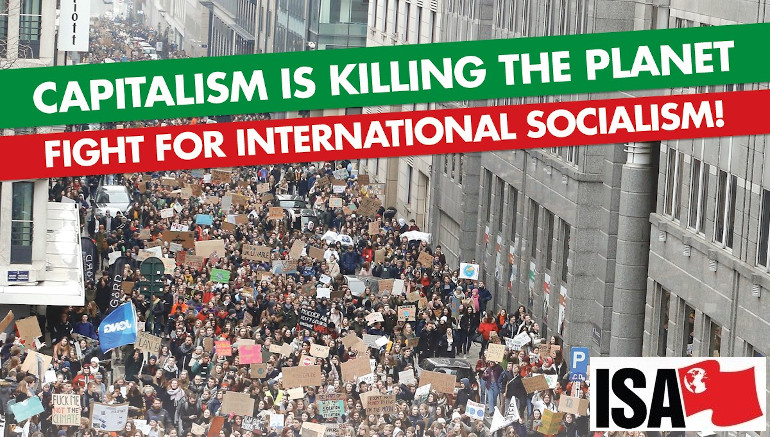They say that money makes the world go round. But does it? Surely, it’s workers who keep the lights on, the trains running and the factories producing. However, few will deny that money is important for greasing the wheels. Both corporate and government money, to varying degrees, are involved in the lubrication process. Concerning climate change, the International Energy Agency estimated in a 2015 report that the world needs to spend $359 trillion between then and 2050 to avoid planetary catastrophe. The calculation shows that investment is woefully inadequate; short by a massive factor of 17.
Helping the developing world — reparations and debt
The world’s richest one percent are responsible for double the carbon emissions of the world’s poorest half, according to Oxfam, but there are few constraints, such as a wealth tax, on them. Recent research suggests that if the combined emissions of wealthy countries were counted against the destruction that the climate crisis is wreaking in poorer countries, the rich would owe the poor $6 trillion a year in “reparations” for the damage caused. A study by the organization Nature Sustainability found that rich industrialized countries responsible for excessive levels of greenhouse gas could be liable to pay $170 trillion in climate reparations by 2050 to ensure targets for climate targets are met. Meanwhile, the debt load of the poorer countries is reaching astronomic levels. The world’s poorest countries were expected to pay 35 percent more in debt interest in 2022 to cover the extra cost of the COVID pandemic and a dramatic rise in the price of food imports, according to a World Bank report.
More than £63 billion will be spent by the 75 countries, many of them in sub-Saharan Africa, that make up the poorest nations, to cover loans taken out mostly over the past decade and the higher interest rates that go with these loans.
Zambia is one of the countries most entwined in a web of debt. The spider waiting for its prey is Black Rock, the world’s largest fund manager, which manages $10 trillion of assets and came under pressure in 2020 to delay demands for debt interest payments from Zambia to prevent the country’s finances from spiralling out of control. If Zambia had paid Black Rock in full, the latter could have made 110 percent profit on the loan. Zambia, which cut health and social care spending by a fifth in the period 2020-2022 to balance its budget, has seen its debts soar to fund infrastructure projects, many to help the country supplement drought-affected hydro power plants. Solar energy projects have made the country almost self-sufficient in electricity, but the high cost of borrowing and the COVID crisis have crippled the country’s finances. From this, it’s clear that it’s not just a question of throwing money at the poor countries for infrastructure projects, including climate-related ones. It’s also a fight to eliminate poverty in those countries. That means it’s also a fight to eliminate capitalism.
Loss and Damage
At the COP 27 meeting in Egypt last year, the official representatives, after many years of resistance, agreed to set up the Loss and Damage fund to cover the most devastating impacts of extreme weather in the poorer countries. It was hailed, at the time, as the best thing to come out from that COP. A future summit was supposed to hammer out the operational details of this fund but didn’t. According to a Guardian analysis of 2021, “a longstanding pledge (since 2009) by rich countries to provide $100 billion a year by 2020 in climate finance to poor countries has still not been fulfilled, and most of the money that flows out goes to emission-cutting projects in middle-income countries, rather than helping the poorest to adapt to climate impacts.”
At COP28, a big fanfare was made of the announcement that $770 million was committed to the Loss and Damage fund. This is 1.3 days of last year’s profits the big 6 western oil companies. The profits of BP, Chevron, Equinor, Exxon Mobil, Shell and TotalEnergies were $219 billion.
Previously-agreed funding to help tackle climate change is not all going to projects that cut emissions. A Reuters investigation found large sums, based on the 2009 pledge, going to projects including a coal plant, a hotel and chocolate shops!
One of the key players in the world of global Finance is the World Bank. It claims to be “the world’s largest financier of climate action in developing countries, delivering over $31.7 billion in our fiscal year 2022.” But according to another Guardian article from October 2022, it “has provided nearly $15 billion of finance directly to fossil fuel projects since the Paris agreement was signed in 2015, and is likely to have spurred far greater investment indirectly.”
Blah blah
The recent world finance conference in Paris, which was supposed to agree the Loss and Damage fund details was heavy on verbiage and weak on specific commitments. The new World Bank president declaimed, “My view is that the World Bank’s vision has to evolve to say, yes, we will create a world free of poverty, but on a livable planet, meaning we tackle climate, pandemics, fragility, food insecurity, things that reduce our ability to have quality of life, and to have hope and optimism” — worthy of a Greta Thunberg “blah blah” response. In fact, Greta was in Paris for the summit, campaigning outside. She said it had missed the point — failing to focus on the greatest source of the problem: fossil fuels. She said rich countries must abandon fossil fuels and must help pay for the rest of the world’s transition, but the summit had barely addressed the issue. She stated that, “If your house is on fire, the first thing you do is to stop pouring oil and gas on to the fire. If you keep adding fossil fuels and fund more oil and gas, you are only fuelling the flames.” Poorer countries struggling with a growing debt crisis were thrown some crumbs at the summit, but the plans still fell short of the debt forgiveness program that many had hoped for.
At the Paris summit, the EU was beating the drum for an expansion of carbon trading, which it believes can raise a large proportion of the revenues needed for climate finance, in both developed and developing countries. More than enough evidence exists to suggest that carbon trading is ineffective, open to corruption and saturated in greenwashing. The Guardian headline for an article on this subject from January 2023 was: “Revealed: more than 90 percent of rainforest carbon offsets by biggest certifier are worthless, analysis shows.” It further commented that the offsets could make global heating worse.
Climate change is real but will the banks fund air conditioning?
The reality of the climate crisis for the poorer countries of the world is shown by what is happening in India — in early June 2023 the Global News headline read “Sweltering India heatwave leaves at least 96 dead, ‘no relief’ on the way.” The majority of the deaths, the elderly, were in the Ballia district in the province of Uttar Pradesh. On one day, the district experienced a maximum temperature of 43 degrees Celsius, surpassing the normal range by five degrees. The heatwaves in India are coming earlier and lasting longer. The India Meteorological Department released a report in April that stated the length of heatwaves had grown by three days over the last 30 years and that they were projected to increase by 12 to 18 days over the next 30 or 40 years. A study by World Weather Attribution, an academic group that examines the source of extreme heat, found that a searing heat wave in April, which struck parts of South Asia, was made at least 30 times more likely by climate change.
Cumulatively, “the top 10 banks in the world generated revenue of $1.35 trillion.” Will the Loss and Damage fund and/or the banks be mobilized to fund India’s need for air conditioning. Only 12 percent of India’s population has AC. A rough calculation to arrive at the cost of providing window AC units for the families in the remaining 88 percent of the population comes out to be around $112 billion. Dipping into these bank revenues would provide the chance to make a lot of Indian’s lives more comfortable while still leaving the banks with considerable profits. However, given that air conditioners are not exactly climate friendly, a better option would be to wean India off its coal dependency with a crash building program of solar farms, requiring an investment worth $2.45 trillion between now and 2030 to meet its clean energy targets. Assuming present trends, the banks’ revenues for this period would amount to over $8 trillion — more than enough to get both clean energy and install environmentally friendly AC.
Don’t worry, be happy, we are the banks
Under the headline “Why Banks Aren’t Too Worried About Climate Credit Risk Yet,” the Financial Post reported that “inside the London headquarters of Standard Chartered (SC), it might be another decade before the reality of a warming planet registers.” SC is a British multinational bank. Around 90 percent of its profits come from Asia, Africa, and the Middle East. Reality isn’t registering for the banks because, in their world, it’s not necessary. A key reason for this is that the fossil fuel industry is currently a gold mine. Elevated energy prices have led to higher revenues for companies in high-carbon, heavily polluting sectors, meaning most have no short-term problems servicing their debt. And most have no need to borrow in order to finance their operations.
Paying lip service to global warming, SC wrote in its annual report that it considers climate change “one of the greatest challenges facing the world today.” It also reaffirmed its promise to eliminate financed emissions by 2050 and to fulfill its pledge to decarbonize its lending to high-carbon industries by 2030. In the last eight years, SC has financed over $46 billion to 149 fossil fuel companies.
Climate change — “qualitatively material” or “quantitatively material”?
The Financial Post had this to say: SC “did consider potential climate-related impacts but it turns out that their impact was so small that the bank decided against including that information in the final analysis.” It’s noteworthy that a leading right-wing journal of finance would comment: “You read that right. In 2022, when London temperatures topped 40C for the first time and one third of Pakistan was submerged in flood waters, climate risks were financially irrelevant for the bank.” [emphasis added] The FP concludes that a key takeaway from the bank’s analysis “is that the full weight of climate change hasn’t yet fed through to its balance sheet.” Or, as the bank says, while it considers climate change to be “qualitatively material” it isn’t yet “quantitatively material.” Translating this into everyday English, it reads — it has to get worse before we take any action that might make it better.
Nationalize the banks
In 2022, Canada’s RBC bank was the biggest funder of fossil fuel projects in the world, providing a total of US$42 billion to fund projects in 2022. Collectively, the big five Canadian banks doled out almost US$140 billion to fossil fuel developments last year. Some in the environmental movement argue for bank regulation to deal with this issue. Banks, in one way or another, have been regulated for years but that hasn’t stopped many of them from disregarding the regulations. It’s control, not regulation, that is needed. In other words, nationalization in order to free up the funds to go where they are most needed.
Green bonds overtake fossil fuel sales — good news, no?
Bloomberg News, on July 5, 2023? reported that “for the first time, companies and governments are raising considerably more money in the debt markets for environmentally friendly projects than they are for fossil fuels.” Sounds good until the reality is examined. RWE AG, a German multinational energy company, generates and trades electricity in Asia-Pacific, Europe and the US. The company is the world’s number two in offshore wind power generation and Europe’s third largest company in renewable energy. It has raised $1.1 billion this year selling green bonds and it says that the proceeds are earmarked for solar and wind projects.
But RWE is also Europe’s biggest greenhouse gas emitter and a major coal developer. RWE generated over 156 terawatt-hours of electricity in 2022. The most used energy source for this was gas, followed by lignite (the lowest grade coal with the least concentration of carbon), and renewables. RWE’s revenue reached €38.4 billion in 2022. April Merleaux, researcher with Rainforest Action said, “The energy transition unequivocally needs more financing, but I’m not convinced that financing for renewables should be going to companies that are opening new coal mines at the very same time.”
Insurance companies duck out from covering climate-related disasters
Closely allied to the banks are the insurance companies. They are another example of private sector entities that can’t be relied upon to respond appropriately to climate chaos. Take State Farm, the largest property insurer in the US, which has announced that it will almost entirely stop issuing new policies in California, the country’s largest property insurance market. The company cited “historic increases in construction costs outpacing inflation, rapidly growing catastrophe exposure, and a challenging reinsurance market.” The catastrophe exposure would be referring to the recent wildfires engulfing bigger parts of the state and lasting longer than before.
In an emergency financial move, in early May, the state-chartered insurance associations in Florida and Louisiana were forced to borrow a combined $1.3 billion to cover claims. As interest rates have risen, borrowing costs have become more expensive. The state of Louisiana has taken on a debt of $600 million to cover hurricane insurance claims and will pay at least $275 million in interest between now and 2038. At the same time, State Farm and other insurance companies have hired lobbyists who, while working to advance fossil fuel industry interests across 18 states, are also in the pay of municipalities who are working to prosecute climate polluters. Some might call this a conflict of interest.
Kate Aronoff, author of Overheated: How Capitalism Broke the Planet — And How We Fight Back, wrote in The Guardian: “Insurance companies are hiking up costs or wholly withdrawing from some areas after deadly, costly flooding in Appalachia and hurricanes in Louisiana and Florida, where property insurance rates are now roughly triple the national average. In each case the rich will make out alright, for now, able to pony up the cost of more expensive policies or relocation. The rest will find themselves on the losing end of what happens when the private sector is entrusted with planning for climate chaos.”
Generous billionaires
It’s nothing new to hear that the rich are making out alright. In this anarchic system called capitalism, there will never be a way for money to get channelled from rich to poor in the quantities that are needed. For sure, some of the individual billionaires out there may have salved their consciences by making charitable donations, some of them to be spent on health, education and climate programs in developing countries. According to Forbes, the world’s most generous billionaires have collectively donated $169 billion in their lifetimes. In 2021 the climate-related public donations of billionaires and their foundations amounted to a mere $2.5 billion. Obviously, if the figure needed to avoid planetary catastrophe is $359 trillion and the amount owed by the rich countries to the poor is $6 trillion, the donations of the likes of Bill Gates and Jeff Bezos are a drop in the ocean.
The rich countries found cash to cope with the COVID pandemic, and to supply arms to Ukraine. It is obvious that it’s not a lack of money or a lack of technology that is the problem. The issue is that the climate crisis is seen as an issue but not the issue — big business will look after itself first. Helping poor countries with the loss and damage they have faced also has to go far beyond the standard disaster responses. When climate-related disasters, such as hurricanes or floods, make their mark, they cause damage not just to physical infrastructure, which donors often concentrate on, but also on social well-being, including health and education. There is also internal displacement, and the resulting problems with social integration. Many countries are already spending an increasing slice of their budgets on climate protection, which could otherwise be spent on health, education and lifting people out of poverty.
Socialist solutions
Capitalism is the problem and socialism is the solution. A socialist planned economy could cut emissions drastically in a short period of time.
- 12 percent of total CO2 emissions come from road transport. By massive investment in free public transport in all cities, transporting goods by rail, and stopping global shipping being used as a means to cut labour costs, these emissions could be cut dramatically and very quickly.
- 6 percent of emissions come from deforestation and fires. Deforestation could quickly be turned into its opposite while fires could be reduced through forest management, more responsible urban planning and reversing cuts to fire services.
- So called “business travel,” which makes up a big part of air travel (12 percent of total air travel in the US), could be dramatically reduced.
- Today’s industry and energy companies create enormous emissions (around 10 percent of emissions) exclusively through ineffective processes. With a planned economy that eliminates unnecessary waste, and energy-saving investments, these emissions could be drastically reduced.
- 17.5 percent of emissions come from energy used in buildings. By insulating buildings, often a quite simple measure, this could be lowered quickly.
- Entire capitalist structures and industries, which are extremely destructive, could be dismantled: the arms industry, the disgustingly wasteful advertising industry, and financial speculation, including crypto currencies.
- Workers in the industries affected should be supported and provided with free training to gain good-paying union jobs in other growing sectors as part of move to a sustainable society.
- The banking and insurance sector would be nationalized. Together with assets of the IMF and World Bank, their combined funds would be directed towards the least developed countries on the basis of zero interest loans.




